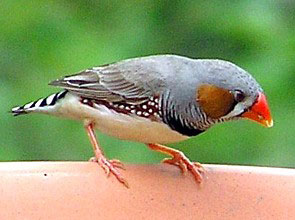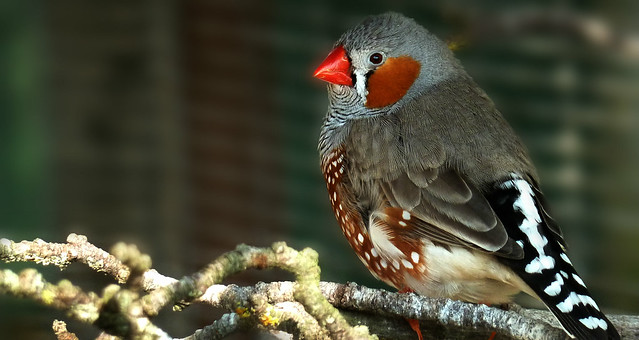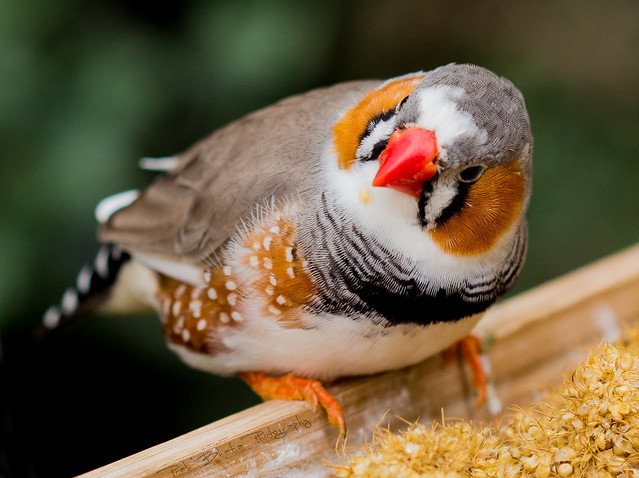 |
| Domesticated Zebra Finch Taeniopygia guttata (Photo credit: Wikipedia) |
Basics
People have called zebras 'flying mice' due to the ease of which they reproduce. This is great if you are looking to start breeding or add a new species to your aviary as it is very little in the way of specific requirements for them.
Zebra finches are happy to live in colonies with their own kind of birds, as well as a huge range of other species. They will live peacefully with nearly all other species of finch, canaries, British birds, doves and even smaller parakeets.
When breeding, both birds can be a little defensive of their nest and will chase other zebras away from it. This is a natural behaviour and will extend when a chick fledges, or leaves the nest, but is never particularly aggressive or result in harm to the other bird. It is more of a noisy, fast-flying warning to keep away from their house.
Feeding zebras is pretty uncomplicated, as well. Use a good foreign finch mix as the basis of your feeding regime and supplement with egg food and some specialist seeds such as niger or hemp seed. Fresh fruit and vegetables are very important for their health, and they will readily consume foods such as spinach, kale and cabbage and fruits such as apple, pear, grapes, mango and plums. With fruit such as apple and plum, remove any seeds or stones as these contain tiny amounts of toxic substances, so better not to take a chance. Access to grit or cuttlefish is also important, especially around breeding time to replace calcium used in making eggs in the hen.
Breeding
Zebra finches don't have a particular breeding season in the way many birds do. They are triggered into breeding condition by light and heat levels or sometimes, for no perceivable reason! They like a variety of nesting materials and are surprisingly good little builders. Coconut fibre, jute, sisal, feathers and even dried grass will all be incorporated into the nest which will usually be a domed affair. They will also happily use a half-open finch nest box or one with a single hole in.
Once the nest is finished, take away surplus nesting material; otherwise, they will keep building and even cover their eggs. Anywhere from 2-7 eggs are laid and are incubated by both birds for around two weeks. When the chicks hatch, they are tiny and nearly hairless, blind and helpless. They are fed by the parents in the nest for around three weeks at which time they fledge fully feathered and resembling an adult save for their black beak. A way of knowing that the bird has matured is that the beak will change from black to bright red for a cock bird or a duller red for a hen.
After fledging, the chicks are fed by the parents for at least two weeks, at which time they may be able to fly or may not be proficient. If they aren't the best at flying, they will seek out corners to hide in so always keep an eye open for fledgelings in odd spots and make sure they don't get themselves stuck.
Zebras can breed at crazy ages of around three months, but it is advisable to wait until at least six months of age before allowing this. One way to ensure this is to keep males and females in separate cages until fully matured.
Keeping Zebras
The lifespan of these little birds is surprisingly long. In the wild, they live around five years but in captivity, 5-7 is average, 12 is possible and the oldest zebra was recorded at 14.5 years of age. They are relatively hardy concerning weather conditions, though any bird should be sheltered from the worst of the climate.
They will happily live in a good-sized cage as a pair or colony, or with other birds. They will also thrive in a flight or large aviary cage and in a flight, can become quite friendly towards humans when they can approach on their own terms. Standing very still with food in hand before the first feed is a good way to win them over, and some may happily hop onto your hand to get in at the food first.
Conclusion
No matter what your experience with birds, zebra finches are a great bird to have. They need little specialist care and can breed easily given a few simple supplies. They come in a range of colours as well and different mutations, so you can quickly get involved in the fun side of genetics and learning which pairing might produce which colours. But all in all, they are fantastic little characters who will quickly win your heart.
Article Source: EzineArticles
|




